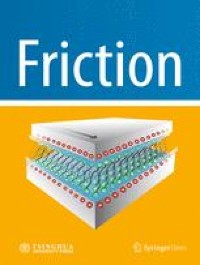Bowden F P, Tabor D. The Friction and Lubrication of Solids. Oxford (UK): Oxford University Press, 2001.
Jungk J M, Michael J R, Prasad S V. The role of substrate plasticity on the tribological behavior of diamond-like nanocomposite coatings. Acta Mater 56(9): 1956–1966 (2008)
Beckmann N, Romero P A, Linsler D, Dienwiebel M, Stolz U, Moseler M, Gumbsch P. Origins of folding instabilities on polycrystalline metal surfaces. Phys Rev Appl 2(6): 064004 (2014)
Chen X, Schneider R, Gumbsch P, Greiner C. Microstructure evolution and deformation mechanisms during high rate and cryogenic sliding of copper. Acta Mater 161: 138–149 (2018)
Rigney D A, Karthikeyan S. The evolution of tribomaterial during sliding: A brief introduction. Tribol Lett 39(1): 3–7 (2010)
Greiner C, Liu Z L, Schneider R, Pastewka L, Gumbsch P. The origin of surface microstructure evolution in sliding friction. Scripta Mater 153: 63–67 (2018)
Argibay N, Furnish T A, Boyce B L, Clark B G, Chandross M. Stress-dependent grain size evolution of nanocrystalline Ni-W and its impact on friction behavior. Scripta Mater 123: 26–29 (2016)
Yan J F, Lindo A, Schwaiger R, Hodge A M. Sliding wear behavior of fully nanotwinned Cu alloys. Friction 7(3): 260–267 (2019)
Greiner C, Gagel J, Gumbsch P. Solids under extreme shear: Friction-mediated subsurface structural transformations. Adv Mater 31: 1806705 (2019)
Rigney D A. Transfer, mixing and associated chemical and mechanical processes during the sliding of ductile materials. Wear 245(1–2): 1–9 (2000)
Chen X, Han Z, Lu K. Wear mechanism transition dominated by subsurface recrystallization structure in Cu-Al alloys. Wear 320: 41–50 (2014)
Stoyanov P, Stemmer P, Järvi T T, Merz R, Romero P A, Scherge M, Kopnarski M, Moseler M, Fischer A, Dienwiebel M. Friction and wear mechanisms of tungsten-carbon systems: A comparison of dry and lubricated conditions. ACS Appl Mater Interfaces 5(13): 6123–6135 (2013)
Padilla II H A, Boyce B L, Battaile C C, Prasad S V. Frictional performance and near-surface evolution of nanocrystalline Ni-Fe as governed by contact stress and sliding velocity. Wear 297(1–2): 860–871 (2013)
Prasad S V, Battaile C C, Kotula P G. Friction transitions in nanocrystalline nickel. Scripta Mater 64(8): 729–732 (2011)
Argibay N, Chandross M, Cheng S, Michael J R. Linking microstructural evolution and macro-scale friction behavior in metals. J Mater Sci 52(2): 2780–2799 (2017)
Stoyanov P, Romero P A, Merz R, Kopnarski M, Stricker M, Stemmer P, Dienwiebel M, Moseler M. Nanoscale sliding friction phenomena at the interface of diamond-like carbon and tungsten. Acta Mater 67: 395–408 (2014)
Klemenz A, Pastewka L, Balakrishna S G, Caron A, Bennewitz R, Moseler M. Atomic scale mechanisms of friction reduction and wear protection by graphene. Nano Lett 14(12): 7145–7152 (2014)
Scharf T W, Prasad S V. Solid lubricants: A review. J Mater Sci 48(2): 511–531 (2013)
Manimunda P, Al-Azizi A, Kim S H, Chromik R R. Shear-induced structural changes and origin of ultralow friction of hydrogenated diamond-like carbon (DLC) in dry environment. ACS Appl Mater Interfaces 9(19): 16704–16714 (2017)
Chen X, Han Z, Li X Y, Lu K. Lowering coefficient of friction in Cu alloys with stable gradient nanostructures. Sci Adv 2(12): e1601942 (2016)
Chen X, Han Z, Lu K. Friction and wear reduction in copper with a gradient nano-grained surface layer. ACS Appl Mater Interfaces 10(16): 13829–13838 (2018)
Wang P F, Han Z, Lu K. Enhanced tribological performance of a gradient nanostructured interstitial-free steel. Wear 402–403: 100–108 (2018)
Stoyanov P, Merz R, Romero P A, Wählisch F C, Abad O T, Gralla R, Stemmer P, Kopnarski M, Moseler M, Bennewitz R, et al. Surface softening in metal-ceramic sliding contacts: An experimental and numerical investigation. ACS Nano 9(2): 1478–1491 (2015)
Li Y S, Tao N R, Lu K. Microstructural evolution and nanostructure formation in copper during dynamic plastic deformation at cryogenic temperatures. Acta Mater 56(2): 230–241 (2008)
Akarca S S, Altenhof W J, Alpas A T. Subsurface deformation and damage accumulation in aluminum-silicon alloys subjected to sliding contact. Tribol Int 40(5): 735–747 (2007)
Xin L, Yang B B, Wang Z H, Li J, Lu Y H, Shoji T. Microstructural evolution of subsurface on inconel 690TT alloy subjected to fretting wear at elevated temperature. Mater Des 104: 152–161 (2016)
Zhou L, Liu G, Han Z, Lu K. Grain size effect on wear resistance of a nanostructured AISI52100 steel. Scripta Mater 58(6): 445–448 (2008)
Sun H Q, Shi Y N, Zhang M X. Wear behaviour of AZ91D magnesium alloy with a nanocrystalline surface layer. Surf Coat Technol 202(13): 2859–2864 (2008)
Rupert T J, Schuh C A. Sliding wear of nanocrystalline Ni-W: Structural evolution and the apparent breakdown of Archard scaling. Acta Mater 58(2): 4137–4148 (2010)
Chen X, Han Z, Lu K. Enhancing wear resistance of Cu-Al alloy by controlling subsurface dynamic recrystallization. Scripta Mater 101: 76–79 (2015)
Hu T, Wen C S, Sun G Y, Wu S L, Chu C L, Wu Z W, Li G Y, Lu J, Yeung K W K, Chu P K. Wear resistance of NiTi alloy after surface mechanical attrition treatment. Surf Coat Technol 205(2): 506–510 (2010)
Wang B, Yao B, Han Z. Annealing effect on wear resistance of nanostructured 316L stainless steel subjected to dynamic plastic deformation. J Mater Sci Technol 28(10): 871–877 (2012)
Mughrabi H, Höppel H W, Kautz M. Fatigue and microstructure of ultrafine-grained metals produced by severe plastic deformation. Scripta Mater 51(8): 807–812 (2004)
Berman D, Deshmukh S A, Sankaranarayanan S K R S, Erdemir A, Sumant A V. Extraordinary macroscale wear resistance of one atom thick graphene layer. Adv Func Mater 24(42): 6640–6646 (2014)


